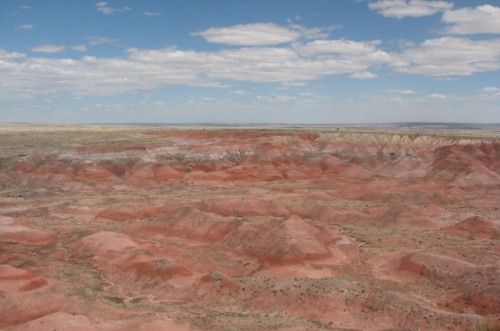In my last post, I shared our visit to the Painted Desert section of Petrified Forest National Park. Then we traveled further south on the road through the park and visited the areas where there is more petrified wood.
As I mentioned in my previous post, this area was part of a sub-tropical river system during the Late Triassic period. Researchers believe the river was about the size of the Amazon or Mississippi Rivers. These soils contain an abundant number of fossils; plants and animals that would have once lived in a river ecosystem. Mollusks, claims, shrimp, insects, amphibians and phytosaurs, which have similarities to modern day crocodiles, are all part of the fossil record here. There are also early dinosaurs. Plant fossils found here include ferns, horsetails, conifers, and several unclassified plants.
The petrified logs that we saw on our visit fell and were washed downstream in the river. They were quickly covered over by sediments, and the organic material was replaced by silica that came from volcanic ash. At that point though, there are two ways that a log can become petrified.
If the silica fills the tree’s cell walls by forming on the inner surface of the walls until the entire cavity of the cell is filled, and then the process of petrification stopped there, the organic cell walls would remain intact. This usually occurred because there was a lack of water at that point. This is called permineralization, and creates a log that is tan and brown and resembles modern wood.
However, if the petrification process continued, and the remaining organic material in the tree degraded and was replaced by more silica crystals, this creates a psuedomorph; a copy of wood. These logs are very colorful, because trace minerals soak into the wood along with the silica. Iron creates mustard yellow, orange, rich red, ochre and black. Blue, purple, brown and black are cause by manganese. Manganese can also create fern-like patterns in the petrified wood.
The detail on these logs is incredible! Some of the logs feature knots where the branches were torn away when the tree traveled downriver. Others have finger-wide holes in the logs; these are caused by damage from prehistoric beetles!
Jon and I stopped at the Jasper Forest overlook, to see where petrified wood that was once trapped in the earth of the bluff have now tumbled down the hill to the valley below. It is neat to see all the chunks of petrified wood down in the valley. The landscape here makes up part of the Sonsela Member, which dates to about 216 Million years ago. It isn’t as colorful as the Blue Mesa Member, but still very beautiful.

Petrified wood below the bluff at the Jasper Forest. This formation is part of the Sonsela Member – at 216 million years old.
We also did a short hike on the Giant Logs Trail that is behind the Rainbow Forest Museum. The wood here is quite large, and you can get right up close to the pieces. The pieces of wood along the Giant Logs Trail are examples of the more colorful type of petrified wood.
I would have loved to spend more time here. There are trails leading to Puebloan ruins and petroglyphs, as well as other trails where you can view more petrified wood. A new trail also opened in spring 2014, which leads to a previously difficult to access section of the park. This trail, called the Devil’s Playground, is only accessible with a back country permit (available at the Visitor’s Center), but gives hikers a view of eroded hoodoos. That will certainly be on the list for the next time we visit.
And one more important mention. In case you weren’t aware, it is a federal offense, punishable with a $350 fine, to steal petrified wood. Of course, lots of people are stupid, so one of the biggest issues for the park is the theft of tons of petrified wood each year. But that’s where the Curse of the Petrified Forest plays a part. Over the years, thousands of people have returned wood that they have stolen over the years, often with letters explaining that they were befallen with terrible luck after they took advantage of the five finger discount. So many people believe in the curse in fact, that the museum has devoted a whole room to the letters and stories of the unlucky offenders.
Have you had the chance to hike in Petrified Forest National Park? And do you believe in the Curse of the Petrified Forest?













































